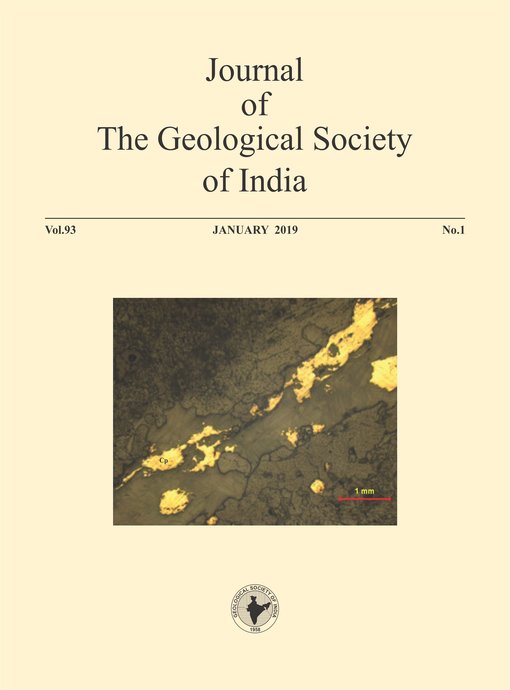Implication from Chemical study of Magnetic Spherules from a Thin Ferruginous Layer Located in Fatehgarh Formation of Barmer Basin, India
DOI:
https://doi.org/10.1007/s12594-019-1122-zAbstract
A unique thin ferruginous layer exist in late Maastrichtian sedimentary sequence of Fatehgarh Formation in Barmer basin, India. Magnetic separation of this layer yielded presence of magnetic glassy spherules of millimetre size. In the present study, XRF, EDXA, INNA are employed to understand the possible origin of these magnetic spherules obtained from this layer. Chemical composition of these spherules strongly favour their volcanic origin.Downloads
Metrics
Issue
Section
Downloads
Published
How to Cite
References
Bhandari, N., Shulka, P.N., Ghevariya, Z.G. and Sundaram, S.M. (1995) Impact did not trigger Deccan Volcanism: Evidence from Anjar K/T boundary intertrappen sediments. Geophys. Res. Lett., v.22, pp.433-436.
Bhandari, N., Verma, H.C., Updhyay, C., Tripathi, A. and Tripathi, R.P. (2002b). Global appearance of magnetic and superparamagnetic iron phases in K/ T boundary clays. Geol. Soc. Amer. Spec. Paper 356, pp.2001-2011.
Blanchard, M.B., Browmlee, D.E., Bunch, T.E., Hodge, P.W and Kyte, F.T. (1980) Meteoroid ablation spheres from deep sea sediments. Earth Planet. Sci. Lett., v.46, pp.178-190.
Bohor, B.F. and Glass, B.P. (1995) Origin and diagenesis of K/T impact spherules from Haiti to Wyoming and beyond. Meteotitics, v.30, pp.182198.
Compton Paul, M. (2009) The Geology of the Barmer Basin, Rajasthan, India, and the origins of its major oil reservoir, the Fatehgarh Formation. Petroleum Geosci., v.15, pp.117-130.
Del Monte, M., Nanni, T. and Tagliazucca, M. (1975) Ferromagnetic volcanic particulate matter and black magnetic spherules: a comparative study. JGR, v.80, pp.1880-1884.
Freeman, R., 1986. Magnetic Mineralogy of pelagic limestone. Geophys. Jour. Royal Astron. Soc., v.85, pp.433-452.
Hagstrum, J.T. (2005) Antipodal hotspots and bipolar catastrophes: Were oceanic large body impacts the cause? EPSL v.236, pp.13-27.
Hildebrand, A.R. and Boynton, W.V. (1990) Proximal Cretaceous Tertiary boundary impact deposits in the Caribbean. Science, v.248, pp.843-847.
Hofmann, C., Bhandari, N. and Ghevariya, Z.G. (2000) Cosmic markers, 40Ar/ 39Ar dating and paleomagnetism of the KT sections in the Anjar Area of the Deccan large igneous province. EPSL, v.182, pp.137-156.
Iyer, S.D., Gupta, S.M., Charan, S.N. and Mills, O.P. (1996b) Volcanogenichydrothermal iron-rich materials from the southern part of the central Indian Ocean Basin. Marine Geol., v.158, pp.15-25.
Iyer, S.D., Prasad, S.M., Gupta, S.M. and Charan, S.N., Mukherjee, A.D. (1997a) Hydrovolcanic activity in the central Indian Ocean Basin. Does nature mimic laboratory experiments. Jour. Volcanol. Geotherm. Res., v.78, pp.209-220.
Koeberal, C. (1993) Instrumental neutron activation analysis of Geochemical and cosmochemical samples: A fast and reliable method for small sample analysis. Jour Radioanalytical and Nuclear Chemistry, v.168, pp.47-60.
Macdonald, G. (1967) In: H. Hess and Arie Poldervaart (Eds.), Basalts. The Poldervaart Treatise on Rocks of Basaltic Composition. New York: Interscience (Wiley) 1, 51p.
Mathur, S. C. and Mathur, S.K. (2003) Sedimentation in Barmer Basin. Jour. Geol. Soc. India, v.61, pp.368-369.
Mathur, S.C., Gaur, S.D., Loyal, R.S., Tripathi, A., Tripathi, R.P. and Ajay Gupta (2005b) Occurrence of magnetic spherules in the Maastrichtian bone bed sedimentary sequence of the Fatehgarh Formation, Barmer Basin, India. Curr. Sci., v.89, pp.1259-1268.
Mathur, S.C., Gaur, S.D., Loyal, R.S., Tripathi, A. and Sisodia, M.S. (2005a) Spherules in the Fatehgarh Formation (Cretaceous) of Barmer Basin, India. Gondwana Res., v.8, pp.579-584.
Mathur, S.C., Mathur, S.K., Loyal, R.S. (2006) First Report of microvertebrate assemblage from Cretaceous Fatehgarh Formation. Jour. Geol. Soc. India, v.67, pp.759-769.
Parthasarathy, G., Bhandari, N., Vairamani, M., Kunwar, A.C. and Narasaiah, B. (2002a). Natural fullerenes from the K-T boundary layer at Anjar, Kutch, India. Geol. Soc. Amer. Spec. Paper 356, pp.345-350.
Parthasarathy, G., Bhandari, N., Vairamani, M. and. Kunwar, A.C., (2008) High-pressure phase of natural fullerene C60 in Iridium-rich CretaceousTertiary boundary layers of Deccan Inter-trappean deposits, Anjar, Kutch, India, Geochim. Cosmochim. Acta, v.72, pp.3.
Sahni, A. and Bajpai, S. (1988) Cretaceous-Tertiary boundary events: The fossil vertebrate, palaeomagnetic and radiometric evidence from Peninsular India. Jour. Geol. Soc. India, v.32, pp.382-396.

 Sonal Mathur
Sonal Mathur






